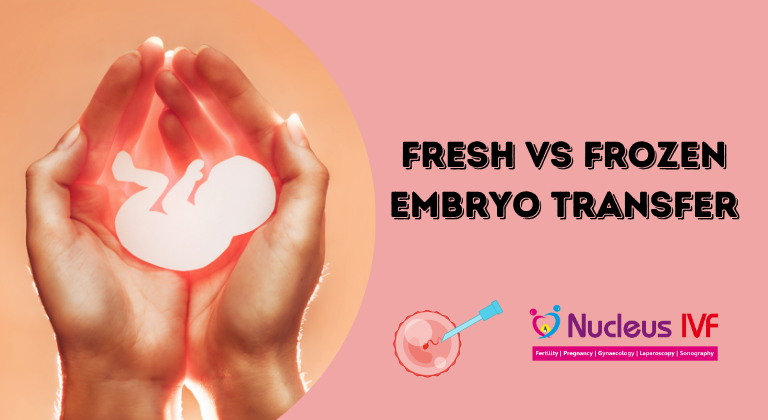Choosing the right IVF protocol is a key factor in determining the success of fertility treatment. Two commonly used ovarian stimulation methods are the Long Agonist Protocol and the Short Antagonist Protocol. While both aim to stimulate the ovaries to produce multiple eggs, their approach, duration, and suitability differ significantly.

At Nucleus IVF, Wakad Pune, under the expert care of Dr. Pritam Sulakhe, treatment is tailored according to individual patient needs. In this blog, we will explain the difference between long and short IVF protocols to help you understand which might be the right option for your journey.
What Is a Long Agonist Protocol?
The Long Agonist Protocol is a traditional IVF protocol and involves a longer preparation phase.
How It Works:
Begins in the previous cycle, typically on Day 21, with administration of a GnRH agonist.
This agonist initially stimulates then suppresses the body’s natural hormones.
After around 10–14 days, once the ovaries are suppressed, gonadotropin injections (FSH or HMG) are started to stimulate multiple follicle growth.
Once follicles are mature, an hCG trigger shot is given, followed by egg retrieval.
Advantages:
More control over ovulation timing
Ideal for women with regular cycles and younger age
Reduces risk of premature LH surge
Disadvantages:
Longer treatment cycle
Can cause more side effects like headaches or mood changes
Slightly higher chance of developing Ovarian Hyperstimulation Syndrome (OHSS)
What Is a Short Antagonist Protocol?
The Short Antagonist Protocol is a more modern, streamlined protocol with a shorter timeline.
How It Works:
Starts on Day 2 or Day 3 of the menstrual cycle with gonadotropin injections.
After 5–6 days of stimulation, a GnRH antagonist is introduced to prevent premature ovulation.
Once follicles reach desired size, hCG trigger is given, followed by egg retrieval.
Advantages:
Shorter duration (approx. 10–12 days)
Lower risk of OHSS
Better suited for older women or those with PCOS
Disadvantages:
May require more monitoring during stimulation
Slightly less predictable in some cases

Key Differences: Long Agonist vs Short Antagonist
| Feature | Long Agonist Protocol | Short Antagonist Protocol |
|---|---|---|
| Start Time | Day 21 of previous cycle | Day 2–3 of same cycle |
| Hormone Suppression | Stronger, via agonist | Short-term, via antagonist |
| Cycle Length | Longer (4–5 weeks) | Shorter (2–3 weeks) |
| Suitability | Younger women, regular cycles | Older women, PCOS, poor responders |
| OHSS Risk | Moderate | Lower |
| Side Effects | More common | Fewer |
Which Protocol Is Better for IVF Success?
There is no one-size-fits-all answer. Success depends on:
Age and ovarian reserve
Hormonal levels
Previous IVF history
Underlying conditions (like PCOS)
At Nucleus IVF Pune, Dr. Pritam Sulakhe evaluates every patient individually. Some women respond better to long protocols, while others benefit more from short protocols.
“The key is to match the protocol with the patient’s physiology, history, and fertility goals,” says Dr. Sulakhe.
Real-Life Example:
A 30-year-old woman with regular cycles may do well on the long protocol to gain better control over hormone levels.
A 38-year-old woman with PCOS might be advised to go with the short antagonist protocol to minimize OHSS risk and reduce cycle duration.
Final Thoughts
Both the Long Agonist Protocol and the Short Antagonist Protocol have their own benefits and are effective when used in the right scenario. The choice of protocol should always be made after a thorough evaluation by a fertility specialist.
At Nucleus IVF, Wakad, Pune, we believe in personalized IVF treatment designed to maximize success and minimize discomfort. Whether you’re a first-time patient or have experienced previous IVF failures, our team is here to guide you every step of the way.
📞 Schedule your IVF consultation today at Nucleus IVF and let Dr. Pritam Sulakhe help you find the most suitable protocol for your success.
Dr. Pritam Prakash Sulakhe
Dr. Pritam Prakash Sulakhe
author
Dr. Pritam Prakash Sulakhe has completed his MBBS from B J Government Medical College , Pune which is one of the top medical College in India. He continued his post-graduation as DGO at same institute. After that he opted for Diplomat Of national Board In Obstetrics and Gynecology from Kerala Institute Of Medical Sciences Trivandrum, which is one of the most prestigious institute from South India.

